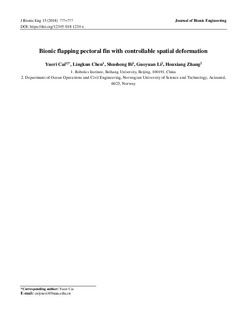| dc.contributor.author | Cai, Yueri | |
| dc.contributor.author | Chen, Lingkun | |
| dc.contributor.author | Bi, Shusheng | |
| dc.contributor.author | Li, Guoyuan | |
| dc.contributor.author | Zhang, Houxiang | |
| dc.date.accessioned | 2019-10-16T08:35:58Z | |
| dc.date.available | 2019-10-16T08:35:58Z | |
| dc.date.created | 2019-10-15T11:17:58Z | |
| dc.date.issued | 2019 | |
| dc.identifier.citation | Journal of Bionic Engineering. 2019, 16 (5), 916-930. | nb_NO |
| dc.identifier.issn | 1672-6529 | |
| dc.identifier.uri | http://hdl.handle.net/11250/2622457 | |
| dc.description.abstract | This paper presents the design of a bionic pectoral fin with fin rays driven by multi-joint mechanism. Inspired by the cownose ray, the bionic pectoral fin is modeled and simplified based on the key structure and movement parameters of the cownose ray’s pectoral fin. A novel bionic propulsion fin ray composed of a synchronous belt mechanism and a slider-rocker mechanism is designed and optimized in order to minimize the movement errors between the designed fin rays and the spanwise curves observed from the cownose ray, and thereby reproducing an actively controllable flapping deformation. A bionic flapping pectoral fin prototype is developed accordingly. Observations verify that the bionic pectoral fin flaps consistently with the design rule extracted from the cownose ray. Experiments in a towing tank are set up to test its capability of generating the lift force and the propulsion force. The movement parameters within the usual propulsion capabilities of the bionic pectoral fin are utilized: The flapping frequency of 0.2 Hz–0.6 Hz, the flapping amplitude of 3°–18°, and the phase difference of 10°–60°. The results show that the bionic pectoral fin with actively controllable spatial deformation has expected propulsion performance, which supports that the natural features of the cownose ray play an important role in designing and developing a bionic prototype. | nb_NO |
| dc.language.iso | eng | nb_NO |
| dc.publisher | Springer | nb_NO |
| dc.title | Bionic flapping pectoral fin with controllable spatial deformation | nb_NO |
| dc.type | Journal article | nb_NO |
| dc.type | Peer reviewed | nb_NO |
| dc.description.version | acceptedVersion | nb_NO |
| dc.source.pagenumber | 916-930 | nb_NO |
| dc.source.volume | 16 | nb_NO |
| dc.source.journal | Journal of Bionic Engineering | nb_NO |
| dc.source.issue | 5 | nb_NO |
| dc.identifier.doi | https://doi.org/10.1007/s42235-019-0106-4 | |
| dc.identifier.cristin | 1737141 | |
| dc.description.localcode | This is a post-peer-review, pre-copyedit version of an article published in Journal of Bionic Engineering. Locked until 11 October 2020due to copyright restrictions. The final authenticated version is available online at: https://doi.org/10.1007/s42235-019-0106-4. | nb_NO |
| cristin.unitcode | 194,64,93,0 | |
| cristin.unitname | Institutt for havromsoperasjoner og byggteknikk | |
| cristin.ispublished | true | |
| cristin.fulltext | postprint | |
| cristin.qualitycode | 1 | |
